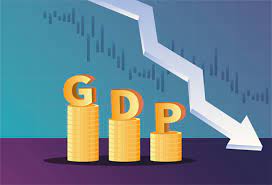- Web Desk
- 3 Hours ago

Top finance body lowers PDM-govt’s GDP growth to -0.17%
-
- Web Desk Shahzad Paracha
- Nov 28, 2023

ISLAMABAD: The National Accounts Committee (NAC) has revised the GDP growth number projected by the Shahbaz Sharif led PDM government to -0.17 per cent, which was provisionally estimated at 0.29 per cent.
Sources said that the secretary Ministry of Planning Development and Special Initiatives approved introduction of quarterly national accounts in the statistical system of the country.
The 107th meeting of NAC to review the annual estimates of GDP for the years 2021-22 (Final), 2022-23 (revised) and quarterly estimates from Q1 2016-17 to Q1 2023-24 was held on Tuesday.
In the 106th meeting of the NAC held in May 2023, the provisional GDP estimates for the year 2022-23 and revised GDP estimates for the year 2021-22 were presented, which are updated on the basis of latest available data.
Final GDP for FY22
The final growth rate of GDP for the year 2021-22 has been estimated at 6.17%, which was 6.10% in the revised estimates. The growth in the agriculture sector has remained stable with fractional improvement from 4.27% to 4.28%, whereas it has improved for industrial activities from 6.83% to 6.95% and services from 6.59% to 6.66%.
As such, mining and quarrying (from -7.0% to -6.58%) and electricity, gas and water supply (from 3.14% to 3.80%) have led to improved growth in industrial activities. The improvement in services is mainly due to information and communication (from 16.32% to 17.96%) and education from 5.66% to 5.85%.
Revised GDP for FY23
The revised growth rate of GDP for the year 2022-23 is estimated at -0.17%, which was provisionally estimated at 0.29%. In the revised estimates, agriculture has significantly improved from 1.55% to 2.25%. Despite reduction in the production of sugarcane (from 91.1 to 88.0 million tons), important crops have been revised upward from -3.20% to 0.42% due to increase in production of wheat (from 27.6 to 28.2 million tons) and maize (from 10.2 to 11.0 million tons).
The other crops have declined from 0.23% to -0.93% due to a decline in production of green fodder (from 192.2 to 190.0 million tons), fruits (-5.6%) and oilseeds (-9.7%). Forestry has improved in revised estimates from 3.93% to 14.2% due to higher production reported by Punjab province.
Despite improvement in electricity, gas and water supply (from 6.03% to 9.84%), the industrial sector growth has declined from -2.94% to -3.76% in the revised estimates due to decrease in LSM (from -7.98% to -9.87%) and construction (from -5.53% to -9.16%). The services sector growth has also declined from 0.86% to 0.07% due to transportation and storage (from 4.73% to 3.27%), information & communication (from 6.93% to -2.55%), finance & insurance (from -3.82% to -8.09%), public administration and social security (from -7.76% to -8.99%), and education (from 10.44% to 9.94%). In the revised estimates, wholesale and retail trade slightly improved from -4.46% to -4.01% whereas human health and social work improved from 8.49% to 10.57%.
As an extraordinary step in the history of macroeconomic statistics of Pakistan, the 107th NAC reviewed, examined and approved the industry-wise methodology of compiling the quarterly GDP as well as series of quarterly growth rates of GDP for various industries from Q1 2016-17 to Q1 2023 by taking 2015-16 as base year.
PBS initiated the work on Quarterly National Accounts (QNA) soon after the approval of a new base of national accounts adopted in January 2022. PBS held discussions with the World Bank for technical assistance on QNA and online technical meetings started on 22nd June, 2022 with the World Bank expert which continued till June 2023. Moreover, a technical committee of national experts reviewed the methodology, sources and results during July-August 2023.
The experts include members from the Ministry of Finance, Ministry of Planning, Development and Special Initiatives, State Bank of Pakistan, Pakistan Institute of Development Economics (PIDE), Quaid-e-Azam University and independent industry.
Later, the IMF included the QNA compilation in its structural benchmark of Stand-By Arrangement (SBA) Program which stated that, “PBS will compile and disseminate the first quarter estimates for 2023-24 and the revised annual estimates for the financial year 2022-23 by end of November 2023”.
To meet the structural benchmark under the IMF-SBA programme, PBS held meetings with stakeholders and data providers and presented the revised GDP numbers for 2022-23 and Q1 2023-24 before the NAC on 28th November 2023.
The committee approved the QNA series from 2016-17 to 2022-23. The committee also approved the first quarter estimates of 2023-24 along with data dissemination and revision policy.
GVA growth rate of 2.13% has been estimated for Q1 2023-24 as compared to Q1 2022-23. Agriculture has shown a growth of 5.06%, industry 2.48% and services 0.82%. In agriculture, crops are posting healthy growth of 6.13% including 11.16% growth in important crops. The major driver for growth in important crops is the increase in sowing area in comparison with the last year.
State Bank predicts 2-3% GDP growth for Pakistan in FY24
For instance, the sowing area for rice, cotton and maize increased by 21%, 11%, and 5%, respectively. It declined by 11% for sugarcane which is offset by the other three major crops.Industry, after witnessing a continuous decline in three quarters in 2022-23 except a modest growth in Q2, has changed its direction in Q1 2023-24 by posting a growth of 2.48%. Mining and quarrying industry is showing positive growth of 2.15% on the basis of quarterly production of the mining sector.
LSM growth is on the basis of quantum index of manufacturing (QIM) which showed a growth of 0.93% in Q1 2023-24. A growth of 0.08% has been reported in electricity generation and distribution, gas distribution and water supply. Construction industry growth has been estimated at 1.73% on the basis of output of construction indicators.
Production of cement surged by 15.38% during Q1 of 2023-24 compared to the same quarter last year, accompanied by positive trends in various indicators. Iron & steel, however, witnessed a negative growth of 2.20% during Q1 2023-24, but its impact was counterbalanced by other indicators. The overall growth in services during Q1 2023-24 is 0.82%. Wholesale and retail trade, reliant on output from agriculture, manufacturing, and imports, is estimated at 3.05%, driven by positive growth in agriculture and industry. Transport reflects a 1.7% growth, based on quarterly data from reliable sources.
Information and communication, previously negative in most quarters last year, changed direction with a 2.4% growth, mainly due to a low base and quarterly information from sources.
The finance and insurance industry experienced a -12.79% growth due to a decline in output from insurance companies, exchange brokers, and mercantile brokers, coupled with high growth in the deflator. Public administration, based on budget documents from federal, provincial, district, and local governments, reported a -16.65% growth in Q1 2023-24.
High deflators contributed to a decline in constant prices, while negative growth in education and human health & social work activities was primarily influenced by declines in government budget data alongside high deflators.
The GDP estimates have been released to meet the IMF structural benchmark under tight deadlines and are grounded in available information and data. However, as a customary practice and considering the time-lag in finalizing data for the last two fiscal years, annual GDP estimates are subject to revision in the NAC meeting scheduled for May 2024.






